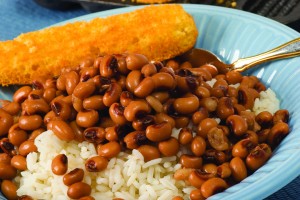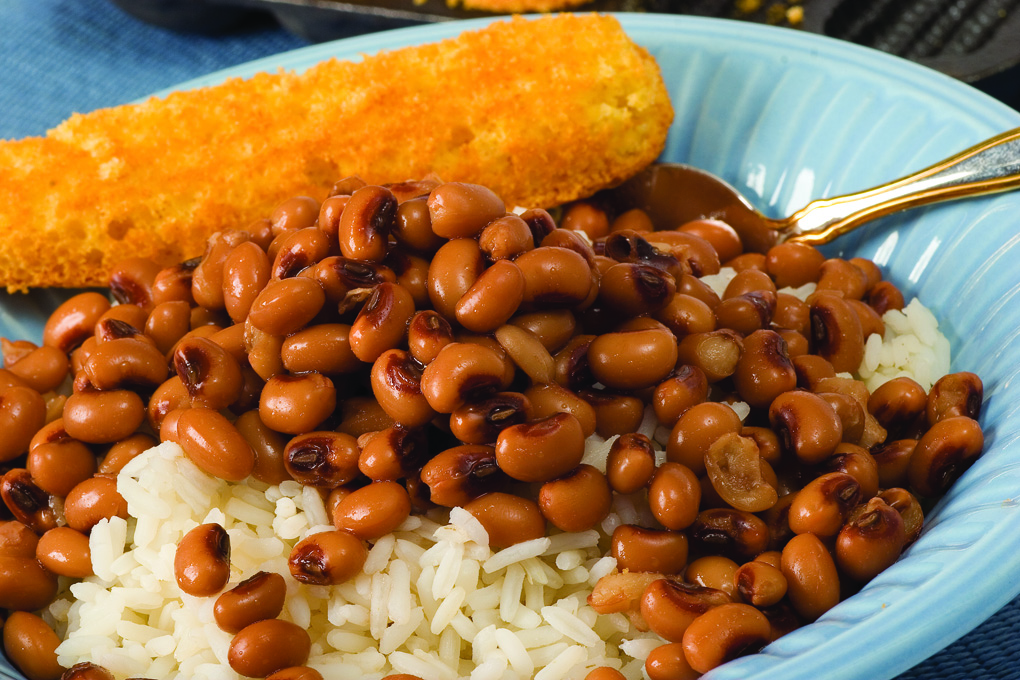Health, Happiness and Prosperity in the New Year ahead!
UKC Cooking Class by Chef Frank Schuchman, 2011
 “Hello Tribune readers! In this week’s NKC Tribune (Jan. 5, 2011 edition), my Frankly Speaking About Good Food column features “lucky” New Year’s food traditions. This supplement to that article is an excerpt from a class that I teach about Southern Cooking. In the class we learn about the colorful history of the foods prepared for New Years. Below are the core ingredients you need to learn to prepare – pork roasts, greens and then black eyed peas and rice to make the famous Hoppin’ John. In the classroom setting I discuss a lot of techniques, so I have re-written these recipes below with the additional information – so don’t be scared at the long narratives ahead, they are there to teach you. I hope that you try each of these flavorful and unique dishes, they are very delicious, fun and easy to prepare!” -Chef Frank
“Hello Tribune readers! In this week’s NKC Tribune (Jan. 5, 2011 edition), my Frankly Speaking About Good Food column features “lucky” New Year’s food traditions. This supplement to that article is an excerpt from a class that I teach about Southern Cooking. In the class we learn about the colorful history of the foods prepared for New Years. Below are the core ingredients you need to learn to prepare – pork roasts, greens and then black eyed peas and rice to make the famous Hoppin’ John. In the classroom setting I discuss a lot of techniques, so I have re-written these recipes below with the additional information – so don’t be scared at the long narratives ahead, they are there to teach you. I hope that you try each of these flavorful and unique dishes, they are very delicious, fun and easy to prepare!” -Chef Frank
Down Home Recipes!
Most Southerners will eat these foods on New Year’s Day, others will make them for the first few weeks of the New Year, while others say “to keep good luck throughout the year, the prepare them all year long!” You will learn how to cook off a pork shoulder roast, prepare fresh greens, make Hoppin’ John, cornbread, honey butter and learn some basic cooking skills & techniques!
Pork Shoulder Roasts – are used most commonly to make pulled (shredded) pork for bbq pork sandwiches, Po’ Boys, rice dishes, jambalayas, soups & stews.
Ah, the humble pig is a reminder for you to be a little humble in the year ahead. The pig also roots its food by moving forward, another blessing that you too will “move forward” or “progress” in the year to come. All forms of pork are eaten during the first few weeks of the New Year such as roasts, chops, hams, sausages, smoked shanks, and bacon.
A pork shoulder roast is a wonderful light flavored cut of pork that is lean and always inexpensive. (Usually half the price of ground beef) This may also be labeled as a “Pork Shoulder Roast” or ”Shoulder Butt” or “Pork Butt” and is similar to a beef chuck roast. Bone-in is cheaper, and they average 7# – 10# pounds. This cut is also widely used in sausage making.
Like a beef chuck “pot roast”, there is a bunch of outside fat that you’ll see, but leave it on to keep your roast moist – it can easily be trimmed off after the roast is fully cooked to reveal the lean cuts inside. And like a beef pot roast, we are going to cook it at a low temperature for a very long time so it does not dry out making it fork tender and juicy!
We do need to add some Southern flavor, and that’s easy, just mix up a batch of herbs & spices called a “Dry Rub”. Once rubbed all over the roast…they will do all of the work! You can leave this rub on the roast for 2 to 24 hours.
View My Recipe for Slow Roasted Pork Shoulder
Greens! Turnip, Mustard, Collards, Chard, Cabbage… the ‘green’ of course represents money, dollar bills, and they wish you prosperity in the year ahead!
Greens are so good for you! Tons of essential vitamins and minerals – more than any head of lettuce could ever attain! They take just a minute to prepare and are packed with wonderful flavors and textures. They are great raw in a salad, quick fire sautéed and served as a side veggie… or just make them your whole meal. Serve with a nice chunk of corn bread! They add a new dimension to just about any soup. They are great served over rice and can go into any pasta sauce.
Collard Greens – these suckers can grow huge! However, bigger is not better. The big leaves are tough, bitter and chewy, so look for the smallest leaves possible. The best I have tasted are the smaller, tender organically grown, sold at better food stores. Collards are one of the most popular greens in the South, so this is where the ‘stewing’ or long (2hrs +) cooking times were developed for their ginormous leaves. The larger leaves can have a thick and woody rib down the center of the leaf, just cut it out and discard to your compost bin.
Mustard Greens – they are very light and delicate, add them at the last second.
Cabbage – is not really considered as “greens” but I really like it so I include it in my recipes. It is the thickest of the greens and should be started first, then add the other greens and finish with the mustard greens. Napa or “curly” cabbage is an excellent choice because it is much thinner and lighter than regular green cabbage.
Garden Growing – all of these greens grow VERY well in Kittitas County. Greens are hardy; they can handle shade and fluctuating soil temperatures. (some of mine will poke through the snow in winter!) Cabbage is a bit of a challenge, one thing is they take a ton of valuable garden space if you have a small garden. Cabbage is also suspect to many different harmful insects. Plant the best local organic seeds you can find. (ask me for my recommendations)
Many in the South will hang up some raw greens to ward off evil spirits!
Hoppin’ John! is simply the combination of cooked black eyed peas served over rice. Here is my version of the traditional New Year’s good luck recipe.
View my recipe for Hoppin’ John
Chef Frank’s Oven Roasted Rice
I prefer to use an oven-browning method for rice making
View my recipe for Chef Frank’s Oven Roasted Rice:
Black Eyed Peas have many positive meanings, first they represent coins! Many say the way they swell into ‘round’ shapes, are like little coins.
Often the cook will toss in a dime or a penny into the bean pot so when someone discovers the coin, they are blessed with a prosperous year ahead*. It is said that you never use a tarnished coin for fear of “tarnishing” the New Year.
Others are reminded of Sherman’s March to the Sea during the winter of 1864 – when Sherman ordered his troops to strip the lands from Atlanta to the ocean of anything that wasn’t nailed down. When they saw black eyed pea plants, they regarded them as useless and they were left behind. (“cowpeas” another name for them, were used as feed for cattle) Leaving thousands of Southerners with a food for the long winter ahead, it is said that the “luck” of the Black Eyed Peas…saved the South!
*Heath Dept, Doctor and Dentist Disclaimer, ok folks do I have to say it? Don’t be tossing coins into your foods! Ha Ha, instead what many restaurants do is to hide a dime under a plate or coffee cup saucer. Then you discover the ‘prosperity’ coin as you are dining.
Eating a heaping bowl of this humble food is so common that many will eat 365 beans, one for luck each day in the New Year.
Yes, these “peas” are actually beans. You’ll love these beans, they have a great flavor and they cook in just a few minutes, rather than the long soaking & cooking times of larger beans like red kidneys, pinto and others.
View my recipe for Black Eyed Peas
“Skippin’ Jenny” is the day after (leftovers) version of Hoppin’ John, and represents frugality, again more good luck in the New Year by starting out being frugal. Much like the common saying in the South: “Eat poor on New Years and be fat for the rest of the year!” Eating humble foods, frugally, will allow you prosperity and happiness in the year ahead.
Chef’s Note: even though you are using bacon as your humble pork, many will simmer the beans with a smoked ham hock, smoked shank or ham bone. This adds a nice smoky aroma and flavor. I highly recommend using a locally smoked shank in bean and soup recipes.
Corn Bread! Please don’t laugh, just follow the directions on the Alber’s Yellow Corn Meal box – it’s what I grew up with and I love it! 400 degrees – 15 minutes and you’ll enjoy them. Make some Honey Butter!
Honey Butter = 1 stick butter (1/4 pound) + 4 TBL Honey (use the best honey you can find – a local organic is my fave)
Soften the butter in the microwave, do not let it become liquid. Add the honey and stir well. Refrigerate and you’re ready to go. Great on the cornbread.
Cakes – in general are also a popular dish on New Years. Most ‘good luck’ cakes are round, symbolizing rings or wholeness. So I make my cornbread either as muffins or in round glass pie plates. Coins too were hidden in cakes… but please don’t do this… if you feel you must, then hide a whole (unshelled) pecan, almond, hazelnut or another favorite nut!
Got Coal?
Probably due to the many countries that raised flags throughout the occupation of the South, other countries too have many similarities to modern day Southern traditions. One is to not only serve these foods, but to take them as gifts to your family and friends – wishing the New Year’s good luck blessings upon them. In some cultures, a lump of coal was given as a wish of a warm and happy new year ahead. Heck, this might just turn into a UKC tradition too!
Last, for continued good luck, prosperity and happiness, eat these foods not only on New Year’s Day, but combine them all year to double and triple your good fortune and as healthy & nutritious meals!
Cheers! Happy New Year!
-Chef Frank





